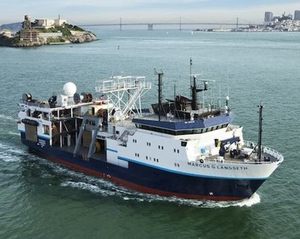NJ sues Feds over academic seismic survey planned for July
Effects of Noise on Wildlife, Ocean, Seismic Surveys Add commentsThe State of New Jersey has gone to federal court to block a seismic survey planned for this month fifteen miles offshore. The survey, funded by the National Science Foundation, received its final permits from the National Marine Fisheries Service last week; the permit (similar to those issued routinely for oil and gas exploration or Navy sonar training) allows the sound from the airguns to incidentally harass marine mammals, including the possibility of some permanent injuries. The New Jersey Department of Environmental Protection is aiming to stop the surveys from commencing in the next week or so; they claim that this is a poor time of year to introduce potentially harmful or harassing sounds, that the surveys could disrupt local fisheries for scallop, flounder, and squid, and that the National Science Foundation should have undertaken a more comprehensive public comment and environmental assessment process.
UPDATE, 8/14/14: Mechanical issues have sidelined the survey for this summer; the National Science Foundation plans to carry out the survey next year instead, while local activists vow to push for more thorough analysis and public input.
 The survey, by Columbia University’s research vessel the Marcus Langseth (left) would examine seafloor sediment, as part of research looking at how climate change has affected river runoff and deposition over the past sixty million years. Some critics, though, seem to be conflating the purpose here with a broader initiative underway to open Atlantic waters for new seismic surveys exploring for oil and gas; those plans have stirred controversy in states up and down the eastern seaboard.
The survey, by Columbia University’s research vessel the Marcus Langseth (left) would examine seafloor sediment, as part of research looking at how climate change has affected river runoff and deposition over the past sixty million years. Some critics, though, seem to be conflating the purpose here with a broader initiative underway to open Atlantic waters for new seismic surveys exploring for oil and gas; those plans have stirred controversy in states up and down the eastern seaboard.
“We believe the timing of this program will be detrimental to various marine species that migrate and breed off the New Jersey coast and will negatively impact the commercial fishing industry that relies heavily on these resources,” said New Jersey DEP commissioner Bob Martin. Similarly, Bob Schoelkopf of the Marine Mammal Stranding Center in Brigantine, was quoted as saying: “Right now, bottlenose dolphins are mating and giving birth off the coast of New Jersey. May and June are the birthing periods. They are totally dependent on their parents to provide nursing for the first two to four years of their life, and if the mother, for some reason, cannot catch fish to eat, she can’t produce milk.” It’s not obvious from these statements whether there is another time of year that either would suggest for a survey such as this.
Meanwhile, the Asbury Park Press spoke to the project’s lead scientist, Rutgers geology professor Greg Mountain, likens the technology to medical sonograms, and says it will cap years of investigations using sea floor corings to recover ancient sediment. The goal is to understand climate and sea level changes over millions of years, information that will be critical to foreseeing future sea level change along the East Coast, Mountain says.
[Click through for more info on seismic surveys in general, and AEI’s quick take on this situation]
Seismic surveys are extremely loud, and repetitive, with air gun blasts several times a minute, lasting for weeks. Their sounds can generally be heard underwater for dozens of miles, though in near-shore waters, propagation can be reduced. Several studies have shown that some species of fish avoid the immediate area of surveys, potentially for a week or more after it ends; however, not all fisheries appear to have been so affected, and it’s not readily clear how close the fisheries of concern are to the survey area. Likewise, it’s not clear from news reports whether the survey is close enough to bottlenose dolphin habitats to create a heightened threat to mothers and young; the coast of New Jersey is subject to intense shipping noise, which bottlenose dolphins apparently tolerate. This is yet another example of increased concern about human noise at sea, a concern we obviously share here at AEI; however, we have also often seen well-intentioned citizens and officials assume the worst in the face of these relatively rare academic seismic survey projects. Given all the industrial seismic that occurs in our oceans, along with chronic shipping noise, it’s not so clear to us that occasional academic surveys are as dangerous as they are sometimes made out to be.
In general, our experience leads us to tend to trust the NOAA/NMFS experts who assess these projects, and to be calmed by the fact that larger seismic surveys undertaken by the oil and gas industry around the world (including intensively in the Gulf of Mexico) have apparently had relatively little effect on local populations of sea life—though the question is difficult to really investigate, given the range of insults to Gulf waters. That said, digging into the project planning documents for this survey, and learning more about the seasonal sensitivity of the species of concern, might show this to be a project that deserves further scrutiny. Time will tell whether a federal judge is able to provide such scrutiny in a timely manner; or, if lacking the expertise to do so, defers to federal regulators and allows the survey to proceed, or to the concerns of the plaintiffs by imposing temporary restraining order pending a full consideration of the claims made in the lawsuit.
